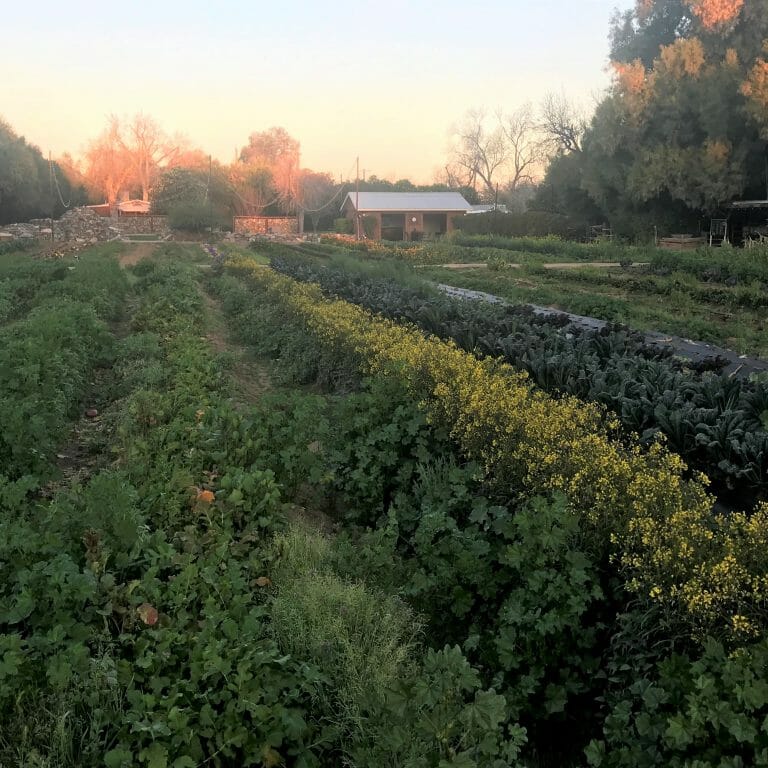
In the mid-20th century, Arizona was one of the most productive agricultural states. Warm temperatures contributed to plentiful harvests of crops such as cotton, alfalfa, and citrus. Arizona’s central cities and rural towns identified with agricultural production. This agricultural tradition is reflected in the Arizona state flag, and occupies 3 of 5 coveted C’s of Arizona (cotton, citrus, cattle, copper, and climate).
Phoenix, the state’s capital and the nation’s 5th largest city, is projected to double by 2040[1]. Agricultural production areas on the peri-urban fringe face rapid development, which is a major threat to regional food systems. Over the past twenty years, agricultural lands have been reduced by 36%[2], and affordable farmland in Phoenix is nearly non-existent. If this pattern of development continues, the city of Phoenix will have no viable farmland within thirty years.
A significant number of farmers and ranchers who rented farmland have lost leased properties to development. This “run-away” development in the Phoenix metro area makes opportunities for affordable farmland rare, and compromises the strength of the regional food system. As a result of such development, farmers and ranchers secure agricultural lands in different cities and counties.
In 2018, the Maricopa County Food System Coalition conducted a food assessment with a nationally recognized food economist, Ken Meter. The following is an excerpt from the report: “On the simple level of economics, Maricopa County consumers spend at least $10 billion each year purchasing food sourced outside of the county, while neighboring farmers struggle to make a living… This is a community heading to a crisis.” The Covid-19 pandemic further highlighted the importance of resilient and regional food systems. It’s now urgent for the Phoenix metro area to invest in regional food systems before it’s too late.
Hospitals have a major effect on regional food systems because of their significant purchasing power, which has the potential to expand the mid-tier food value chains of Phoenix. Arizona has long been a healthcare destination. The arid and dry conditions made desert climates like Phoenix and Scottsdale desirable places for tuberculosis patients in the 1920’s. People seeking relief from asthmatic and arthritic conditions also flocked to desert environments because of the warm winters and absence of humidity around this time. As a result of this preference for climate and healthcare, Arizona evolved into an influential healthcare destination. According to the American Hospital Directory, there are 133 hospitals in Arizona, more than surrounding states like Colorado, New Mexico, and Utah. Fifty-two of Arizona’s hospitals are located within Maricopa County and almost 20% (26 of 133) of the hospitals in Arizona are located in the capital city of Phoenix.
Across all major diagnostic categories, Phoenix area hospitals discharged the most patients in Arizona, with a total of 450,840 patients discharged in 2019[3]. The large and aging baby boomer population, paired with increased life expectancies, is anticipated to further escalate Phoenix’s high use of healthcare systems through more hospital visits and therefore increased intakes, treatments, and surgeries. Fifty percent of hospitals reported annual food and beverage budgets between $500,000 – $5,000,000[4]. Hospitals within this budget range serve between 123-307 patient meals per day. Hospitals also retail food and beverage products, including cafeteria meals, vending machines, and gift shop sales.
As anchor institutions, hospitals have the potential to create new purchasing structures for regional food products and production. Hospitals as individual enterprises are large buyers and collectively hold significant purchasing power across the food system. For example, the average meal and beverage budget of hospitals with more than 120 beds is $2,750,000[5]. Increasing local purchasing for the 32 large hospitals within Maricopa county by 5% has the potential to generate $4,400,000 for regional markets. Increasing the local purchasing power of hospitals in Phoenix can be a watershed for other significant improvements. Increasing the local purchasing power of hospitals in Phoenix can also improve farmers’ livelihoods, diversify income streams for rural agricultural communities, increase diversity within the regional ecosystem, improve health outcomes, and improve hospital care. Beyond direct purchasing, hospitals have vested interests in public health, heat mitigation, and community wellbeing and resilience.
Sources:
[3] https://gis.azdhs.gov/hospitalcompare/comparecounties.html
[4] https://www.foodservicedirector.com/operations/2016-healthcare-census-hospitals-raise-their-game
[5] https://www.foodservicedirector.com/operations/2016-healthcare-census-hospitals-raise-their-game